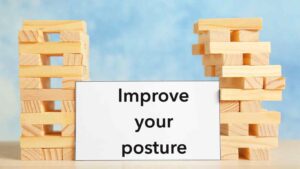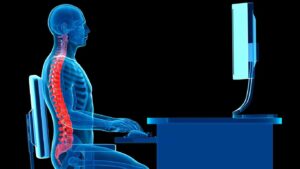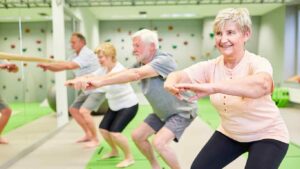‘The Posture Myth’: “Is it because my posture is bad”?
By Sport & Exercise APA Titled Physio Rick Bain
 Posture has been long engrained in our psyches when discussing pain and for good reason. We’ve been told for years that bad posture is the ‘root of all evils’ and is the most common reason for why people suffer from back, neck and shoulder pain.
Posture has been long engrained in our psyches when discussing pain and for good reason. We’ve been told for years that bad posture is the ‘root of all evils’ and is the most common reason for why people suffer from back, neck and shoulder pain.
How many times have you heard “sit up straight, it’s not good for your back”?
You don’t have to look far these days to find a “health professional” on the internet or TV describing all the bad things that result from bad posture and the (often expensive) remedies required to ‘fix it’.
What if I told you there is a multitude of studies that have compared postures of pain free people with those with back, neck and shoulder pain and found no difference?
Don’t let the facts get in the way of a good story! Let me present a snapshot of the facts to you.
Here are some findings of the research into the link between pain and posture:
• No association between leg length inequality and back pain.
• No significant difference in lumbar lordosis (arch in your low back) or leg length inequality between three groups of 321 males with severe back pain, moderate pain, or no pain.
• No association between measurements of neck curvature and neck pain.
• No significant difference in lumbar lordosis, pelvis position, leg length discrepancy, and the length of abdominal, hamstring, and iliopsoas (deep front hip muscles) in 600 people with and without back pain.
• Teenagers with postural asymmetry, excessive thoracic kyphosis and/or lumbar lordosis were no more likely to develop back pain in adulthood than peers with “better” posture.
• Pregnant women with greater increases in low back curve during pregnancy were no more likely to develop back pain.
• People who work occupations involving frequent awkward postures do not have higher levels of back pain.
 Some studies have found a positive association between measurements of spinal alignment and pain; however, these are exceptions to the rule. The summary of evidence is best demonstrated by a systematic review done in 2008, that analyzed more than fifty-four studies on the relationship between pain and posture.
Some studies have found a positive association between measurements of spinal alignment and pain; however, these are exceptions to the rule. The summary of evidence is best demonstrated by a systematic review done in 2008, that analyzed more than fifty-four studies on the relationship between pain and posture.
The cumulative analysis of all the studies into posture did not produce evidence supporting an association between measurements of spinal alignment and pain.
Even more interesting, is that many studies have found other factors such as stress, smoking, education levels, job satisfaction, and exercise, to have a larger contribution to back pain.
 Even if a relationship between pain and posture does exist, prospective studies suggest it is not a causal relationship (ie: posture does not cause pain). It may be that pain causes bad posture, and not the other way around.
Even if a relationship between pain and posture does exist, prospective studies suggest it is not a causal relationship (ie: posture does not cause pain). It may be that pain causes bad posture, and not the other way around.
Moreover, even if bad posture does contribute to back pain, it is yet another leap to conclude that posture can be corrected. And yet another to prove that correcting “bad” posture will reduce back pain.
What Is Important Then?
The above evidence suggests there is no “ideal posture” and that “correcting posture” has no effect on preventing pain. So if posture isn’t important, should we not worry about it at all? Hmmmm…
1. Become an active sitter:
If your occupation or hobbies involve maintaining a prolonged stationary position for many hours and causes you pain, regular subtle changes to your posture may be better strategy rather than trying to hold some “ideal posture”.
No-body is designed to tolerate prolonged positions of any kind, even if it involves “good posture”. I regularly advise my clients to “become an active sitter”. Take regular breaks or change positions regularly. In essence, all this means is ensure regular changes to your posture or position as this will help distribute forces and stresses of body weight to many various body areas and tissues, thus reducing the stress on any one area of the body.
2. Reverse your curve:
The way you move is more important than how you look sitting or standing still. It is ok to sit with a rounded upper back at times, as long as you don’t lose the ability to extend your upper back in the opposite direction.
Another little ditty my clients hear a lot is to “reverse the curve”. Ie: if you sit with a rounded back posture a lot during the day, make sure you spend time in the day to “reverse that curve” by stretching and extending your spine in the opposite direction.
3. Ensure good alignment when high forces are involved:
Your body is pretty good at adapting to tissue stresses and loads of everyday activity such as prolonged standing and sitting, and this is just one reason posture doesn’t really matter. However, do not mis-interpret that posture doesn’t matter when you are doing high load tasks that require a lot of strenuous effort such as lifting weights, sprinting, jumping/landing.
Alignment and posture matters in these circumstances and is important to be conscious of your alignment and technique to minimize your risk of injury.
 Forget good posture: think good movement
Forget good posture: think good movement
In summary, don’t worry too much about trying to change your static posture to conform to some ideal. It is not a likely contributor to your pain. Instead, stay comfortable, keep moving, work to improve your function, and make sure to use good alignment and form when engaged in strenuous exercise. If your’e not sure your pain is as a result of your posture or positions of everyday life, please discuss this with one our physiotherapists. Phone 07 5500 6470 or book online for an appointment.
Happy Doing and Feeling GOOD!

































